Potassium deficiency in cannabis plants

Noticing yellowing leaf tips or burnt edges? You could be dealing with a potassium deficiency. Whether you're a first-time grower or troubleshooting mid-flower issues, this guide will help you identify, fix, and prevent potassium problems for a stronger, healthier cannabis crop.
Are you noticing burnt leaf edges or yellowing tips? A potassium deficiency could be silently stunting your cannabis plants.
Potassium influences the health of cannabis plants in numerous ways, affecting flowering, water regulation, nutrient transport, and other key processes. So when your plants don't get enough of this essential macronutrient, symptoms like yellowing leaf tips, crispy edges, and weak growth can start to appear quickly! In many cases, these signs are initially subtle (at least in soil), making potassium deficiency one of the more difficult nutrient issues to detect early.
In our guide, we'll explore how to spot potassium deficiency in cannabis, how it manifests during different stages of plant development, and most importantly, how to fix and prevent it. With tips perfect for single plants or a small-scale operation, you'll find practical solutions to keep your cannabis thriving.
Early symptoms of potassium deficiency
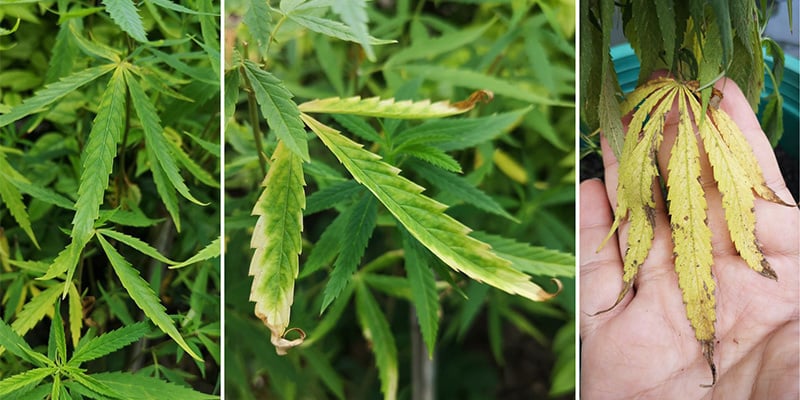
When growing in soil, potassium deficiency often begins with subtle symptoms. That said, when growing hydroponically, plants can show signs of distress much quicker. In any case, if left untreated, a deficiency can significantly impact plant health, development, and final yield.
Therefore, recognising the early signs can make a huge difference and is key to preventing long-term damage. Below is a breakdown of symptom progression by stage, along with a timeline to help you track the severity of the deficiency.
Early stage
The first signs of potassium deficiency often show on older fan leaves. Yellowing begins at the tips, accompanied by small brown or rust-coloured spots between the veins. Leaves may look slightly faded or dull. While plants still appear mostly healthy, nutrient transport and regulation are already being affected internally.
Mid stage
As symptoms intensify, leaf edges start to burn and curl. Twisting or clawing may appear, and the discolouration can spread from the margins inward. The plant's health is now clearly compromised, and swift action is needed to avoid further decline.
Late stage
In the most severe cases, leaves become dry, brittle and drop off easily. Growth slows dramatically, and bud development may be delayed or underwhelming. At this point, potassium deficiency can seriously affect the plant's yield, potency, and overall resilience.
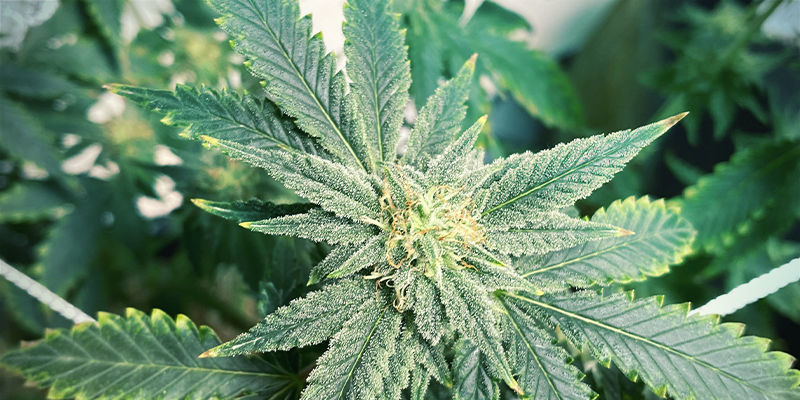
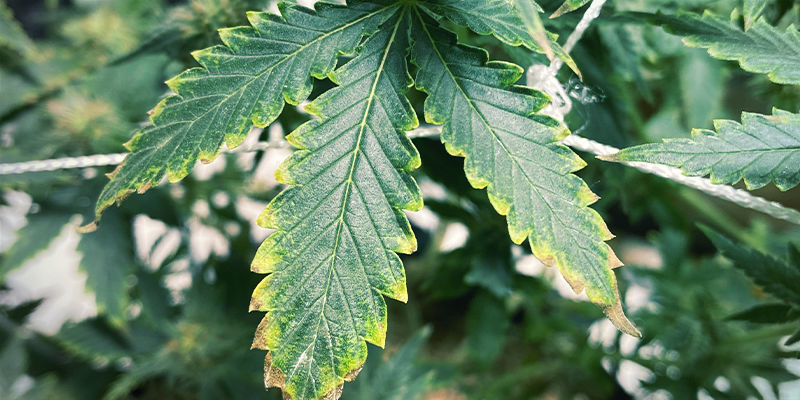
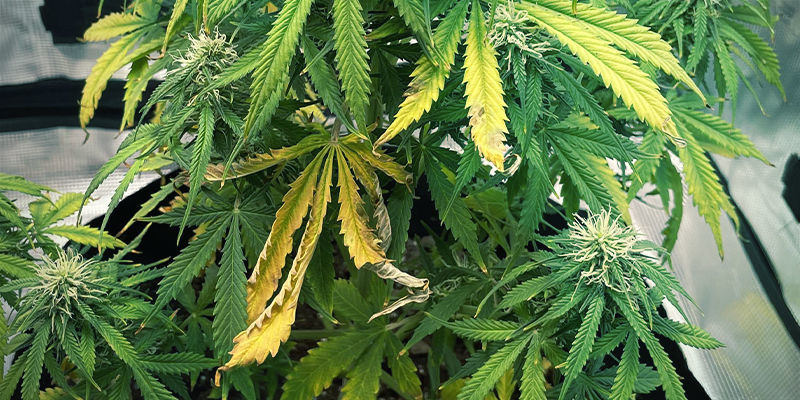
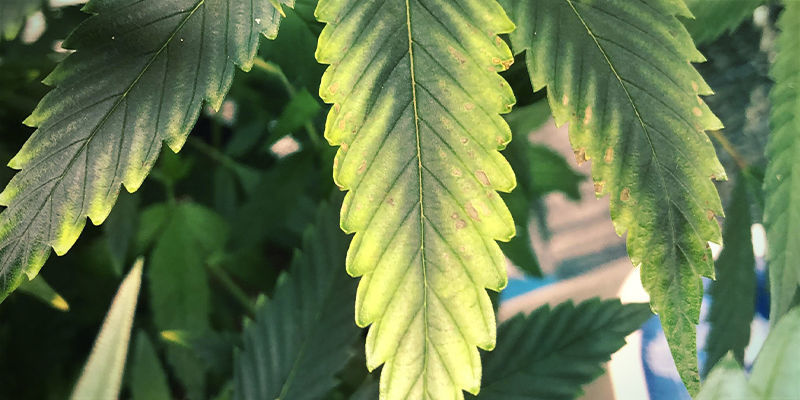
Week 1: Yellowing at leaf tips & occasional brown spotting
Older leaves may develop pale or yellowing tips in the first stage of potassium deficiency, sometimes accompanied by small brown or rust-coloured spots. At this point, the plant may show only a slight reduction in photosynthetic efficiency, with few visible signs.
Week 2: Necrotic spots deepen & edge burn begins
As the deficiency progresses, the brown spotting becomes much more pronounced and spreads. Leaf edges may show signs of scorching, and curling (either upward or inward) often begins. This signals severe disruption to the plant's nutrient flow.
Week 3: Tips and edges become dry and brittle
By the third week, the affected leaves will become dry, fragile, and discoloured. Potassium's key role in nutrient transport is now compromised, leading to slower growth and a visible decline in the plant's structure and strength.
Week 4: Severe curling and crisping
In advanced stages, leaves may curl tightly, crisp at the edges, and show widespread discolouration. Bud development begins to suffer, and the overall yield and quality of the plant may be permanently impacted if no action is taken. For a detailed overview of the most common nutrient deficiencies, check out our dedicated article.
.jpg)
How to confirm it's a potassium deficiency
Before adjusting your nutrient regimen, it's important to confirm that what you're seeing is truly a potassium deficiency and not another plant ailment with similar symptoms. Several issues, including pH imbalance or nutrient lockout, can mimic potassium-related problems.
Rule out pH imbalance and nutrient lockout
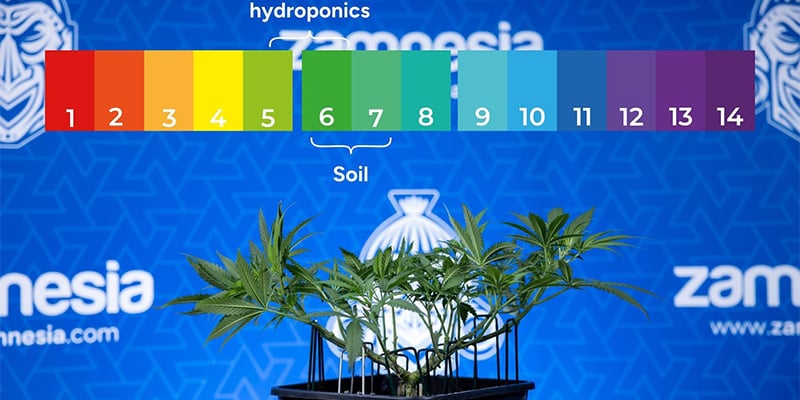
Cannabis plants require a specific pH range to absorb potassium efficiently, typically between 6.0 and 7.0 in soil and 5.5 and 6.5 in hydroponics. If the pH drifts outside these ranges, potassium may become unavailable to the plant, even if it's present in the growing medium. This is known as nutrient lockout, one of the most common causes of false deficiencies.
However, before increasing potassium levels, always check and adjust the pH first. A well-balanced pH environment will often resolve the issue without altering your feeding schedule.
Visual confirmation vs other deficiencies
As mentioned, potassium deficiency shares symptoms with other issues, particularly magnesium and calcium deficiencies. Here's a quick guide on how to distinguish it:
- Potassium deficiency: Yellowing and browning at the tips and edges of older leaves, edge burn, upward curling
- Magnesium deficiency: Interveinal yellowing that starts in the middle of the leaf
- Calcium deficiency: Irregular brown spots and distorted new growth
To confirm a potassium deficiency, match your observations with symptom patterns and plant stage. If you're unsure, review your grow conditions and feeding history to help narrow it down.
For more guidance on how pH and other factors impact nutrient uptake, check out our article on nutrient availability.
Fixing potassium deficiency in cannabis
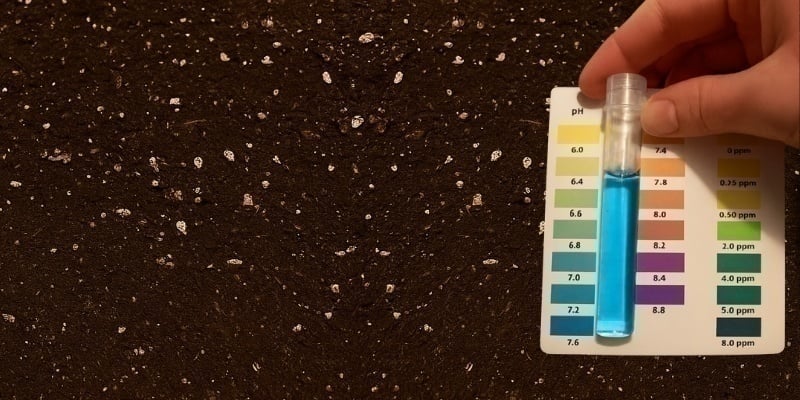
Once you've identified and confirmed a potassium deficiency, the next step is to correct the issue before it affects plant health and final yield. Here's a step-by-step approach to restoring balance.
Adjust pH to optimal levels
Before adding any supplements, start by checking and correcting your pH. If potassium is locked out due to improper pH levels, no amount of feeding will solve the issue. Use a calibrated pH meter and gradually adjust pH with up/down solutions until you hit the ideal range for your growing medium. If you suspect build-up, flush your medium with clean, pH-balanced water.
Use potassium-rich supplements
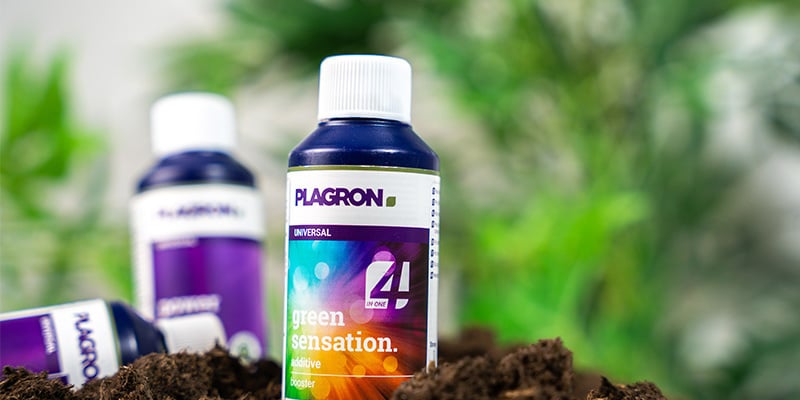
If pH is in range and symptoms persist, it's time to supplement. Look for cannabis fertilisers containing potassium sulfate or potassium phosphate; or, if you prefer an organic approach, you can use kelp meal, wood ash, or composted banana peels. Always follow label instructions, and be careful not to overfeed, as excess potassium can interfere with magnesium and calcium uptake.
Monitor and correct NPK ratios
Balanced nutrition is essential. Cannabis plants need different NPK (nitrogen, phosphorus, potassium) ratios at each growth stage:
- Vegetative stage: Higher nitrogen with moderate potassium
- Flowering stage: Lower nitrogen and higher phosphorus and potassium
Review your feeding schedule and fertiliser products to ensure you're not overloading nitrogen at the expense of potassium. For detailed guidance, visit our article on how to adjust nutrient delivery.
Can I still use affected plants or buds?
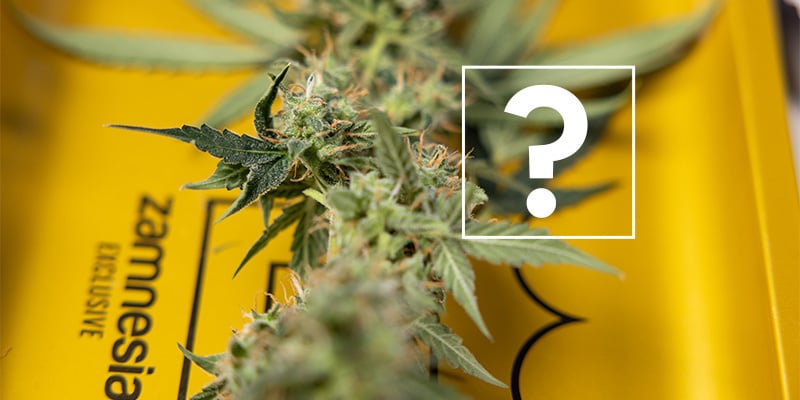
Cannabis affected by potassium deficiency is generally safe to consume, as the condition does not introduce any harmful compounds into the plant. However, while they may still be usable, the overall quality of the buds can be significantly compromised. Density, size, potency, and flavour can all be adversely affected, making for a less satisfying experience overall.
Preventing potassium deficiency
Preventing potassium deficiency starts with maintaining a stable and supportive growing environment. Regularly monitoring pH and electrical conductivity (EC) ensures that nutrients remain available to your plants, as even slight imbalances can lead to lockout and deficiencies. As mentioned, aim for pH levels suited to your grow medium. Alongside pH, keeping a balanced feeding schedule tailored to your plant's growth stage is essential. Avoid overloading nitrogen during flowering, and ensure potassium levels are increased appropriately.
Lastly, using high-quality soil blends or properly maintained hydro setups provides the perfect foundation for nutrient uptake and overall plant health, reducing the risk of imbalances that could lead to deficiencies.
What is potassium and why is it important?
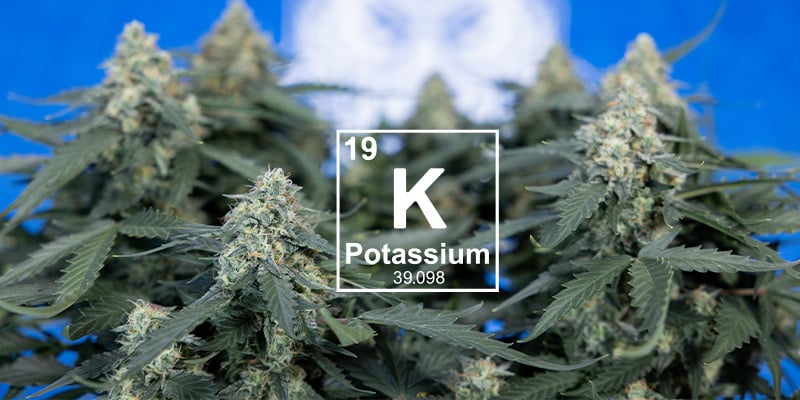
Potassium (K) is one of the three primary macronutrients essential for cannabis growth, alongside nitrogen (N) and phosphorus (P). While it doesn't form part of the plant's physical structure, potassium plays a vital regulatory role in several biological processes that directly impact plant health and productivity. Here are some areas where potassium is vital.
Water regulation
Potassium helps control the opening and closing of stomata, the tiny pores on leaves that manage gas exchange and transpiration. Proper stomatal function allows cannabis plants to efficiently take in carbon dioxide and release oxygen, while also regulating moisture levels. Without enough potassium, plants struggle to retain water and become more susceptible to heat stress and drought.
Flowering support
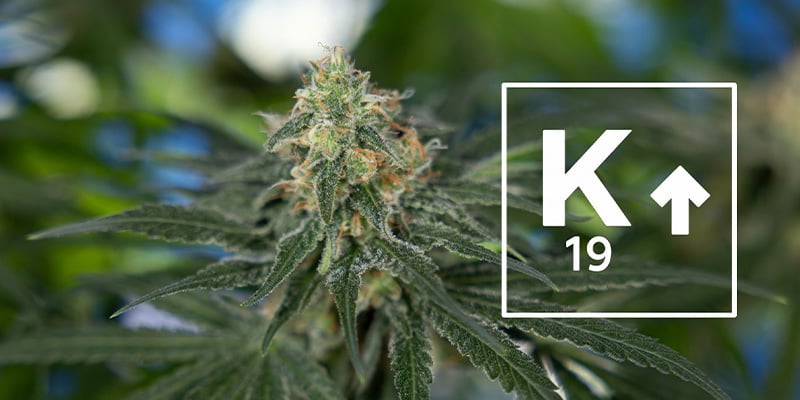
During the pre-flowering and flowering stages, cannabis plants demand higher levels of potassium to fuel bud development, sugar transport, and enzyme activation. Adequate potassium ensures dense, resinous flowers and supports the movement of nutrients to growing sites. A deficiency at this stage can result in weak, airy buds with massively reduced potency and yield.
Photosynthesis and energy transport
Potassium is key to photosynthesis, helping to convert light energy into chemical energy. It also facilitates the movement of carbohydrates and sugars through the plant's vascular system, ensuring that energy reaches all tissues efficiently. When potassium levels drop, this energy flow slows down, stunting growth and weakening the plant's immune system.
Nutrient interactions
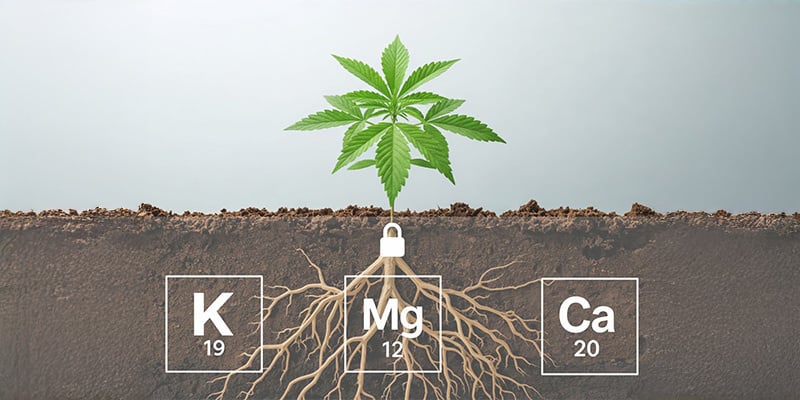
Potassium also interacts closely with other nutrients, particularly calcium and magnesium. However, it's possible for an imbalance to appear in the root zone, leading to nutrient lockout, even when potassium is technically available in the growing medium. This delicate balance makes monitoring nutrient and pH levels essential to prevent cascading deficiencies.
Potassium requirements during pre-flowering and flowering stage

As cannabis plants shift from vegetative growth to flowering, their nutritional needs change, especially when it comes to potassium.
Pre-flowering (weeks 1–2)
During pre-flowering, plants experience a rapid growth spurt often referred to as the “stretch”. Within a short 1–2-week window, cannabis can double or even triple in height. To sustain this rapid development, plants require elevated levels of potassium, alongside nitrogen and calcium. Potassium at this stage helps to strengthen stems, regulate water movement, and prepare the plant for the intense metabolic activity of flowering.
Flowering phase
Once the stretch ends and flowering begins, potassium becomes even more critical. Growers typically boost potassium levels in parallel with phosphorus, while reducing nitrogen to shift the plant's focus from vegetative growth to bud production. From this point onward, potassium supports flower formation, improves nutrient transport, and enhances the aroma, flavour, and density of the buds. Deficiencies during this stage can result in smaller yields, poor trichome development, and weaker plant health overall.
Potassium: Fundamental for cannabis plants
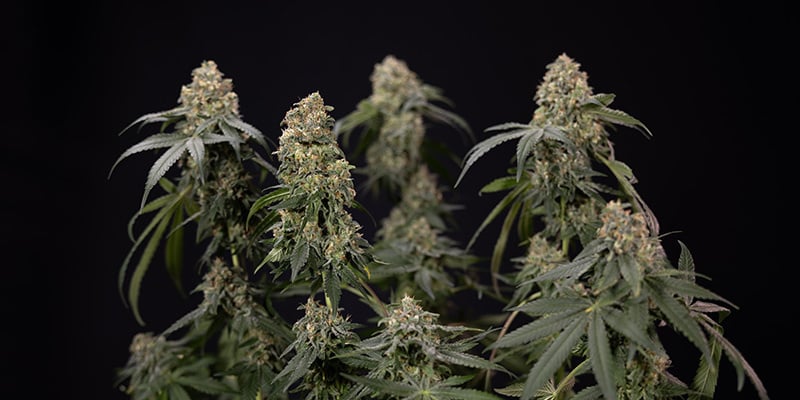
As you can see, potassium is truly fundamental in cannabis cultivation, supporting many processes that can make or break the health and productivity of your plants. Recognising and addressing deficiencies early can make the difference between a thriving harvest and a disappointing yield.
To keep your plants healthy, regularly check pH and EC levels, adjust feeding schedules as needed, and monitor for visual symptoms during critical growth stages. Tools like digital pH pens, EC meters, and nutrient-specific supplements like potassium sulfate can help you stay in control. With proper care and proactive management, potassium-related issues can be corrected quickly, keeping your plants strong, stable, and productive.





 United States
United States











